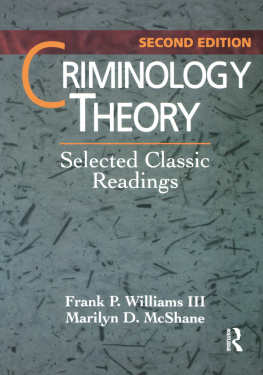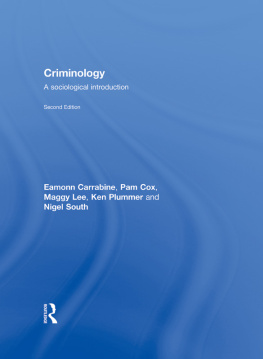Routledge Revivals
Women, Crime and Criminology
First published in 1977, Women, Crime and Criminology presents a feminist critique of classical and contemporary theories of female criminality. It addresses the issue that criminology literature has, throughout history, been predominantly male-oriented, always treating female criminality as marginal to the proper study of crime in society. Carol Smart explores a new direction in criminology, and the sociology of deviance, by investigating female crime from a committed feminist position.
Examining the types of offences committed by female offenders, Smart points to the fallacies inherent in a reliance on official statistics and shows the deficiencies of the popular argument that female emancipation has caused an increase in female crime rates. She deals with studies of prostitution and rape and considers the treatment of women as offenders and victims by the criminal law, the police and courts, and the penal system. Particular attention is given to the question of lenient treatment for female offenders with the conclusion that women and girls are, in some important instances, actually discriminated against in our legal and penal systems. The relationship between female criminality and mental illness is discussed and the author concludes by dealing with some of the problems inherent in developing a feminist criminology.
Women, Crime and Criminology
A Feminist Critique
Carol Smart
First published in 1977
by Routledge & Kegan Paul Ltd
This edition first published in 2013 by Routledge
2 Park Square, Milton Park, Abingdon, Oxon, OX14 4RN
Simultaneously published in the USA and Canada
by Routledge
711 Third Avenue, New York, NY 10017
Routledge is an imprint of the Taylor & Francis Group, an informa business
1977 Carol Smart
All rights reserved. No part of this book may be reprinted or reproduced or utilised in any form or by any electronic, mechanical, or other means, now known or hereafter invented, including photocopying and recording, or in any information storage or retrieval system, without permission in writing from the publishers.
Publishers Note
The publisher has gone to great lengths to ensure the quality of this reprint but points out that some imperfections in the original copies may be apparent.
Disclaimer
The publisher has made every effort to trace copyright holders and welcomes correspondence from those they have been unable to contact.
A Library of Congress record exists under ISBN: 77350404
ISBN 13: 9780415644174 (hbk)
ISBN 13: 9780203079676 (ebk)
Women, Crime and Criminology:
A Feminist Critique
Carol Smart
Department of Social Studies Trent Polytechnic, Nottingham
First published in 1977
by Routledge & Kegan Paul Ltd
39 Store Street,
London WC I E 7DD,
Broadway House,
Newtown Road,
Henley-on-Thames,
Oxon RG9 I EN and
9 Park Street,
Boston, Mass. 02108, USA
Filmset in Monophoto Ehrhardt 11 on 12 pt by
Richard Clay (The Chaucer Press), Ltd, Bungay, Suffolkand printed in Great Britain by
Fletcher & Son Ltd, Norwich
Carol Smart 1977
No part of this book may be reproduced inany form without permission from thepublisher, except for the quotation of briefpassages in criticism
ISBN 0 7100 8449 8
To Vera and Ernest
Contents
I have received help and support from many people during the writing of this book. In particular I want to thank Barry Smart for his unfailing intellectual and emotional support, and Mary Mclntosh, Nigel Armistead, Ian Taylor and George Brown for their critical and constructive comments on various stages of my manuscript. Of course these individuals are in no way responsible for the completed work. I would also like to acknowledge the support I have received from members of the BSA Womens Caucus who gave me sufficient confidence to complete this book. Finally my thanks to Rene Shaw for typing my manuscript.
This book began as a postgraduate dissertation which I wrote for a Masters degree in criminology. It was during this time as a postgraduate that I became aware of the overwhelming lack of interest in female criminality displayed by established criminologists and deviancy theorists. As I was interested in the topic of female criminality I began to do work in the area and soon came to realize that very few books on the subject were readily available. Even those that had been published were not to be found in libraries; in fact there was a considerable silence surrounding the whole area. I began searching for sources and found that quite a large number of articles had been written on female criminality and delinquency but these tended to be in medical journals or in American publications. Undeterred I collected material but it was not until I began to read it that I realized that the one thing most of the papers and books had in common was an entirely uncritical attitude towards sexual stereotypes of women and girls. From Lombroso and Ferrero (1895) to Cowie, Cowie and Slater (1968) and from W. I. Thomas (1967, originally published in 1923) to G. Konopka (1966) the same attitudes and presuppositions reappeared, confirming the biologically determined inferior status of women not only in conventional society but also in the world of crime and delinquency.
The material that I uncovered presented mainly cultural stereotypes and anti-feminist ideology, the rare exceptions being papers by Heidensohn (1968), Klein (1973), Velimesis (1975) and a few others. Increasingly it became obvious to me that, as a first step at least, what was required was a feminist critique of existing studies of female criminality. The majority of these studies refer to women in terms of their biological impulses and hormonal balance or in terms of their domesticity, maternal instinct and passivity. I felt that such distorted views should not be left unchallenged and, although there is obviously a need for substantive empirical study of this subject, I was convinced that the existing ideological framework which supported the existing studies and theories had to be critically examined and revealed for what it was, namely fallacious and inadequate, before more empirical studies could cast any light on the phenomenon. I view this book therefore simply as a beginning, as an attempt to adopt a new direction towards the study of female criminality.
In writing such a book, documenting and criticizing existing studies, making a case for the necessity of further research on female criminality and delinquency, certain problems emerge. The first is that women and crime may come to be treated as a discrete area within criminology. That is it will receive a token lecture in a course on criminology along with such topics as mentally abnormal offenders or twin studies, while the main course will remain undisturbed, continuing to be concerned with the real or important issues, namely explaining male criminality and delinquency. Such a treatment of female criminality would ensure that the discipline of criminology could remain unmoved by any feminist critique. The second problem which arises is that of making female criminality into a visible social problem. I hesitate to add to a body of literature that might be used to identify or discover another problem, to create another moral panic. It is not beyond the bounds of reason to imagine that if agents of social control and the mass communications media become sensitized to a new problem their subsequent actions may well lead to the appearance of increases in the rates of crimes and an escalation in the reports of violent and criminal offences by women and of delinquency in girls. A comparable event was perhaps the appearance of mugging in the early 1970s. Mugging, or mugging-type offences, were known previously in the UK but the adoption of a new label for an old offence created a situation in which it appeared that a new social problem had emerged.





